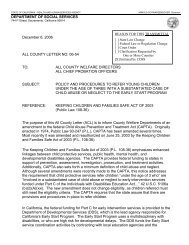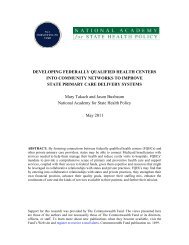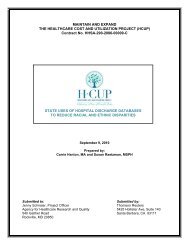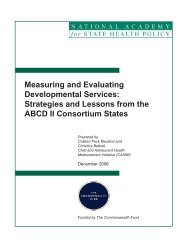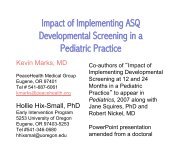Improving Care Coordination, Case Management, and Linkages to
Improving Care Coordination, Case Management, and Linkages to
Improving Care Coordination, Case Management, and Linkages to
Create successful ePaper yourself
Turn your PDF publications into a flip-book with our unique Google optimized e-Paper software.
30<br />
pediatrics clinic, which is a case management meeting involving a variety of service providers within the Navajo<br />
Nation. Originally focused on child abuse, the clinic was exp<strong>and</strong>ed <strong>to</strong> include children with varying complex <strong>and</strong>/<br />
or chronic issues, such as diabetes, high risk newborns <strong>and</strong> children with or at-risk of emotional <strong>and</strong>/or behavioral<br />
issues. 93<br />
Early Childhood Comprehensive Systems (ECCS)<br />
Since 2002, Title V federal set-aside funds have been used <strong>to</strong> support the Early Childhood Comprehensive Systems<br />
(ECCS) initiative <strong>to</strong> help states develop more comprehensive approaches <strong>to</strong> early childhood service delivery.<br />
Nearly every state has developed a plan for improved integration of early childhood services <strong>and</strong> systems.<br />
The five core components are:<br />
•<br />
•<br />
•<br />
•<br />
•<br />
access <strong>to</strong> health care <strong>and</strong> medical home;<br />
mental health;<br />
early care <strong>and</strong> education;<br />
family support; <strong>and</strong><br />
parent education.<br />
In some states, local entities support early childhood system integration. States provide money <strong>to</strong> communities<br />
<strong>to</strong> support their systems efforts, promulgate rules or guidance; or provide staff or written technical support for<br />
local systems development. Most states combine funding with guidance or technical assistance for community<br />
leaders. 94<br />
The Great Start System Blueprint in Michigan (an ECCS plan) was approved by Governor Granholm <strong>and</strong> the<br />
Children’s Cabinet with two main priorities: 1) creating a public-private entity <strong>to</strong> oversee implementation of<br />
the state’s early childhood system plan (Early Childhood Investment Corporation), <strong>and</strong> 2) developing local<br />
early childhood systems. Implementation efforts are led by 14 local Great Start Collaboratives (GSC), which<br />
have funding <strong>and</strong> staff <strong>and</strong> are managed through Intermediate School Districts. 95 Each local collaborative uses a<br />
results-based accountability framework, conducts a local systems review <strong>and</strong> produces a community report card<br />
on the outcomes for young children <strong>and</strong> their families. Each GSC is required <strong>to</strong> include parents in the community-level<br />
leadership <strong>and</strong> planning efforts. Web-based resources <strong>and</strong> communications help link parents <strong>and</strong> service<br />
providers, including primary care providers. 96<br />
Vermont’s Building Bright Futures (BBF), which was created in 2006 by executive order, supports the creation<br />
of a unified, sustainable system of early care, health <strong>and</strong> education for young children <strong>and</strong> their families. ECCS<br />
<strong>and</strong> BBF’s work at the state level has led <strong>to</strong> the establishment of 12 BBF Regional Councils for community-level<br />
systems building. The existing local Early Childhood Councils in each of Vermont’s 14 counties were used as the<br />
base for creating new BBF Regional Councils, which will have staff <strong>and</strong> more responsibility for local decision making.<br />
State funding supports staff in each region. The regional BBF councils bring <strong>to</strong>gether parents, providers, employers<br />
<strong>and</strong> others at the community level <strong>to</strong> support creation of an integrated early childhood system, develop a<br />
regional plan, advise the state BBF Governing Council <strong>and</strong> moni<strong>to</strong>r child <strong>and</strong> family outcomes. Regional planning<br />
efforts are guided by data <strong>and</strong> indica<strong>to</strong>rs in a results-based accountability framework. Current year plans include<br />
an array of efforts <strong>to</strong> better link health, Part C, home visiting, early childhood mental health, early care <strong>and</strong> education<br />
<strong>and</strong> other community resources.<br />
<strong>Improving</strong> <strong>Care</strong> <strong>Coordination</strong>, <strong>Case</strong> <strong>Management</strong>, <strong>and</strong> <strong>Linkages</strong> <strong>to</strong> Service for Young Children: Opportunities for States<br />
National Academy for State Health Policy



